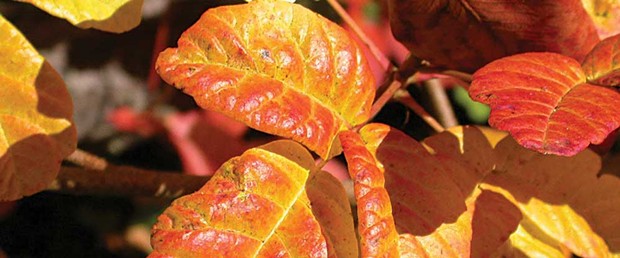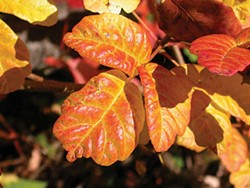Rash Decisions
Your guide to battling poison oak
By Linda Stansberry [email protected] @lcstansberry[
{
"name": "Top Stories Video Pair",
"insertPoint": "7",
"component": "17087298",
"parentWrapperClass": "fdn-ads-inline-content-block",
"requiredCountToDisplay": "1"
}
]
Exactly why I was thrashing around in the brush behind a trailer park south of Alton is a story for another day. But suffice to say my adventure did not come without a price. On Wednesday I was itchy. On Thursday I was scratchy. On Friday I was blotchy. By Saturday I looked like the Elephant Man. I called Anne Carlisle, a nurse practitioner at Humboldt Dermatology, for some advice on how to help readers learn from my mistakes.
Prevention
Some people are immune to poison oak and can go clambering willy-nilly through vegetation without a second thought. The rest of us need to examine our terrain closely. The plant is easy to identify when it still has leaves ("leaves of three, let it be"), especially when it turns a deep pink color in the fall, but the leafless stalks in the winter are equally laden with urushiol, the oil that makes us break out in a rash. To be safe, learn to identify the plant in all seasons and try not to touch any vegetation you're not sure of. If you think you may have been exposed, avoid touching your face or genitals until you can wash up.
Once you've made it back to civilization, quick action is your best bet. That Tecnu stuff they sell for an exorbitant price at the drug store? It works. Shimmy off those clothes and throw them in a bucket with cold water and the recommended amount of special sauce. Then wash yourself down as well, taking care to use cold water. No Tecnu at hand? Several friends swear by dish soap. It makes sense. Urushiol is an oil, and dish soap will do the job of removing any oil. Follow up with regular soap. Go over any contaminated gear with Tecnu. Don't forget your car's seatbelt. Or your dog. No dish soap, no nothing? My Karuk friend says their go-to is jumping straight in the ocean, letting the salt water do its thing. Neither Carlisle nor I can confirm its efficacy. She does warn that there's no such thing as obtaining immunity through repeated exposure. In fact, the opposite is true.
"The first time a patient is exposed to the oil it may take three weeks for them to develop a reaction," Carlisle says, "But every subsequent time will develop quicker and be more severe."
Stage One: Itchy and Scratchy
So you did your best to clean up, but you're starting to notice that your skin feels like it's on fire. Scratching it feels sooooo good, as does running it under hot water. Do neither of those things. I promise you, it is no bueno. Put a topical steroid on those spots and ignore them. If you really can't stand it, slap the itchy spots instead of scratching them. Prescription antihistamines can calm the itching so you can sleep. Doctors can treat severe cases with prednisone, but Carlisle isn't a fan of this method, as it requires a tapering three-week oral dose and comes with some side effects. Many of my outdoorsy friends swear by this magic stuff you can find at the pharmacy called Zanfel. It's not cheap, but it does seem to do a good job at drying up the rash and it's an exfoliant, so you get the satisfaction of scratching without using your dirty fingernails. Scratching, Carlisle warns, can cause a staph infection.
Stage Two: Bumpy and Oozy
By now you will have received all sorts of dubious advice from your friends. Bleach! Scalding hot water! Eating manzanita leaves by the light of a full moon! (Actually, a tea made from young manzanita leaves is a traditional preventative measure, but let an expert brew it.) Trust your Auntie Linda: Don't do anything that's going to be bad for your skin in the long run. Don't pick at or pop the pustules, just suffer through. To help dry up the oozing, you can make a great poultice using aloe, plain oatmeal, lavender oil and plantain. For extra ahhhh, refrigerate the oatmeal first. By the way, poison oak is not contagious. The oil will transfer from your clothes to other people (ask any logger's spouse) but your rash won't get them itchy. Don't be surprised if your friends don't want to hug you, though.
Stage Three: Dry and Flaky
So you've gone from Elephant Man to Freddy Krueger. Don't scratch. Don't pick. Keep your skin moisturized (Vitamin E oil works well) while it heals. You'll be back to your old, handsome self in a few days. Want to avoid retriggering your rash? Here's a surprise: Carlisle says that raw cashews can reintroduce an allergic reaction. So skip the mixed nuts. And maybe skip thrashing around in strange brush for a while, too.
more from the author
-
Lobster Girl Finds the Beat
- Nov 9, 2023
-
Tales from the CryptTok
- Oct 26, 2023
-
Graduation Day: A Fortuna Teacher Celebrates with her First Grade Class
- Jul 18, 2023
- More »
Latest in Get Out
Readers also liked…
-
A Walk Among the Spotted Owls
- Apr 27, 2023


































